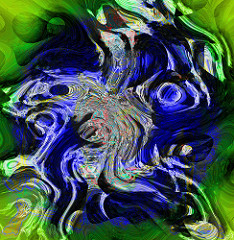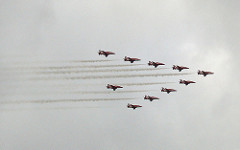Ch. 4 Organic Chemistry (Study of Chemical Reactions) – Flashcards
Unlock all answers in this set
Unlock answersquestion
Thermodynamics
answer
Branch of chemistry concerned with energy changes accompanying chemical and physical transformations. The basic energetics of the reaction at equilibrium.
question
Mechanisms
answer
The step by step description of exactly which bonds break and which bonds form in what order to give the observed products.
question
Kinetics
answer
The study of reaction rates, determine which products are formed the fastest/slowest. Also predicts how rate changes if we change reaction conditions.
question
Quantum yield

answer
The percent of energy given back as light emission from an excited fluorochrome. Also the ratio of Carbon atoms fixed or Oxygen molecules produced to the number of photons absorbed.
question
Chain Reaction
answer
The mechanism consisting of three steps (initiation, propagation, termination) that explains the formation of a product.
question
Initiation Step
answer
The preliminary step in the chain reaction that generates a reactive intermediate. In chlorination this step leads to the formation of free radicals after chlorine absorbs blue light.
question
Propagation Step
answer
Secondary step in the chain reaction where the reactive intermediate reacts with a stable molecule until the supply of reactants is gone or the reactive intermediate is destroyed. In chlorination it involves the removal of a hydrogen from methane, and the reaction of the methyl radical with Cl⁻ to form CH₃Cl.
question
Termination Step
answer
The third and final step of the chain reaction in which side reactions destroy reactive intermediates(usually free radicals) and tend to stop or slow product formation.
question
Free Radicals
answer
Species with unpaired electrons(Cl⁻, Br⁻, OH⁻, CH₃-, CH₃CH₂- for example), that are electron deficient because they lack an octet. These readily combine with electrons in other atoms to form a bond. Are sp² hybridized and planar.
question
Reactive intermediate
answer
A short-lived species that is never present in high concentrations because it reacts as quickly as it is formed.
question
Equilibrium constant
answer
Ratio of the concentrations of the products to the concentrations of the reactants at the point of equilibrium, where each reactant and product in the expression is raised to the power of its stoichiometric coefficient. Signified Keq= e⁻(ΔG/RT)
question
Gibbs Free Energy
answer
The measure of the amount of energy available to do work. Denoted by G, an negative value of delta G means that reactions can occur spontaneously.
question
standard Gibbs free energy
answer
This is the equation for _______ _______ ______ _________ .ΔG⁰ = ∑vΔG⁰(products) - ∑vΔG⁰(reactants), can also equal -RT(ln Keq) or -2.303RT(log Keq)
question
Enthalpy
answer
The change in energy of a chemical reaction Denoted by (ΔH). This is a measure of the relative strength of bonding in the products and reactants.
question
Entropy
answer
A quantitative measure of disorder or randomness, symbolized by S.
question
Chlorination
answer
The substitution reaction of methane(CH₄) with chlorine requires light and heat to take place at a useful rate. The most effective wavelength for this reaction to happen is blue. Very high quantum yield. Forms chloromethane(CH₃Cl) in first step.
question
Einstein
answer
Defined as a mole of photons.
question
Regeneration
answer
The _______________ of a free radical is characteristic of a propagation step in a chain reaction.
question
Bleomycin
answer
An anti-tumor antibiotic which is used for the treatment of testicular cancer. Works by generating highly reactive hydroxyl radicals, which damage and degrade the DNA of the rapidly dividing tumor cells.
question
Reverse Reaction
answer
This is favored in situations where the equilibrium constant(Keq) is less than 1. Means that reactants are more prevalent at equilibrium.
question
Forward Reaction
answer
This is favored in situations where the equilibrium constant(Keq) is more than 1. Means that more products are more prevalent at equilibrium.
question
Standard State
answer
For a pure substance, the most stable form of the substance at 1 atm and a specified temperature, usually 25°C(298 K): for a gas, 1 atm; for a solution, concentration of 1 molar.
question
Lowest enthalpy
answer
Reactions tend to favor products with the strongest bonds or __________ ___________.
question
Arrow of time

answer
This concept is provided by the 2nd law of thermodynamics, which implies that time is asymmetrical with respect to the amount of order in an isolated system: as a system advances through time, it will statistically become more disordered.
question
Poincaré recurrence theorem
answer
States that certain systems will, after a sufficiently long time, return to a state very close to the initial state.
question
Bond dissociation energy
answer
The amount of energy required to break a particular bond homolytically(so that each bonded atom retains one of the two electrons).
question
Homolytic Cleavage
answer
The breaking of a bond to form two neutral species. Free radicals result. Used to define bond dissociation energies because values do not vary much with different solvents.
question
Heterolytic Cleavage
answer
The breaking of a bond to produce a pair of oppositely charged ions.
question
Rate of reaction
answer
The rate at which products appear and reactants disappear. This can be determined by measuring the concentration of the reactants with time.
question
Rate law
answer
Also called the rate equation. This is the relationship between the concentration of reactants and the observed reaction rate. ALWAYS determined experimentally by changing concentrations. Usually in the form rate = kr[A]^(a) x [B]^(b).
question
Rate constant
answer
The proportionality constant that relates the rate of a reaction and the concentration of reactants, must be determined experimentally.
question
Overall order
answer
The sum of all the orders of reaction(a+b+c etc...). These are the exponents that appear in a general rate law added together.
question
Arrhenius Equation
answer
An equation that relates the rate constant(kr) for a reaction to the frequency factor, the activation energy, and the temperature. Kr = Ae^-(Ea/RT). The exponential term of this equation is VERY important because it is the fraction of collisions with enough activation energy to react.
question
Platinum
answer
Frequently used as a catalyst. Increasing the surface area of this will be extremely useful if one wants to increase the rate of reaction and the overall order of a reaction is zeroth.
question
Activation Energy
answer
Defined by Arrhenius as the minimum amount of kinetic energy molecules must have to overcome the repulsions between their electron clouds when they collide.
question
Frequency Factor
answer
This constant accounts for the frequency of collisions and fractions of collisions with PROPER orientation for the reaction to occur.
question
Transition state
answer
The highest energy state in a molecular collision that leads to reaction. Is unstable and cannot be isolated. Symbolized by a superscripted double dagger (‡).
question
Reaction energy diagram
answer
A plot of potential-energy changes as the reactants are converted to products. The vertical axis is potential energy (usually free energy, but occasionally enthalpy). The horizontal axis is the reaction coordinate, a measure of the progress of the reaction.
question
Catalyst
answer
A substance that causes or hastens a chemical reaction by creating a transition state of lower energy, which in turns lowers the activation energy.
question
Rate limiting step
answer
This is the highest energy step of a multi-step reaction.(Look at highest transition state) Determines rate of entire reaction.
question
Hammond Postulate
answer
Related species that are closer in energy are also closer in structure. The structure of a transition state resembles the structure of the closest stable species. Explains why exothermic reactions are less selective than endothermic ones.
question
Radical inhibitors
answer
A compound such as a phenol that selectively reacts with radicals to remove them from a chain reaction and terminate the chain. (ability to terminate radical chains before significant damage to the food occurs, are often referred to as preservatives)
question
BHA
answer
Butylated hydroxyanisole. Is added to foods as an antioxidant. Stops oxidation by reacting with radical intermediates to form stable free radical intermediates.
question
Phenol
answer
An aromatic ring(think benzene) with an -OH group.
question
Vitamin E

answer
A phenol which acts as an antioxidant in the cell membrane protecting the cell from damage, plays a role in synthesis of hemoglobin or serve a pro-oxidant effect by activating enzymes in the mitochondria.
question
Ascorbic acid

answer
Another name for vitamin C, used as an antioxidant and is added as a buffer in order to prevent degredation in liquids.
question
Carbocations
answer
Carbon with a positive charge with only six valence electrons. They have no nonbonding electrons and are positively charged. Is a very powerful electrophile (Lewis Acid). It is sp₂ hybridized, with a planar structure and bond angles of about 120°
question
carbanions
answer
Have trivalent carbon atoms that bear a negative charge. A strong neuclophgile(Lewis base), has the same basic electrical structure as an amine. Sp₃ hybridized and tetrahedral.
question
Carbene
answer
A highly reactive species with only two bonds to an uncharged carbon atom with a nonbonding pair of electrons. The simplest is methylene, :CH₂.
question
Inductive Effect
answer
A donation (or withdrawal) of electron density through sigma bonds. Happens in carbocations because they are electron deficient and withdraws the electron density from the alkyl groups attached to it.
question
Resonance stabilization
answer
Stabilization that takes place by delocalization of electrons in a π bonded system. Carbocations, cations, radicals, and anions are often stabilized by this.
question
Hyperconjugation
answer
Interaction of electrons in a sigma-bonding orbital with the vacant 2p orbital of an adjacent positively charged carbon overlap.
question
Vitamin B₁₂
answer
Also called cobalamin, is a water-soluble vitamin with a key role in the normal functioning of the brain and nervous system, and for the formation of blood. It contains the biochemically rare element cobalt and deficiency of it leads to some symptoms seen in pernicious anemia. Works y stabilizing methyl radicals by helping produce two different enzymes.



